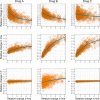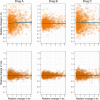Enteric reabsorption processes and their impact on drug pharmacokinetics
- PMID: 33707635
- PMCID: PMC7952424
- DOI: 10.1038/s41598-021-85174-w
Enteric reabsorption processes and their impact on drug pharmacokinetics
Abstract
Enteric reabsorption occurs when a drug is secreted into the intestinal lumen and reabsorbed into the systemic circulation. This distribution process is evidenced by multiple peaks in pharmacokinetic profiles. Commonly, hepatobiliary drug secretion is assumed to be the underlying mechanism (enterohepatic reabsorption, EHR), neglecting other possible mechanisms such as gastric secretion (enterogastric reabsorption, EGR). In addition, the impact of drug reabsorption on systemic clearance, volume of distribution and bioavailability has been a subject of long-standing discussions. In this work, we propose semi-mechanistic pharmacokinetic models to reflect EHR and EGR and compare their respective impact on primary pharmacokinetic parameters. A simulation-based analysis was carried out considering three drug types with the potential for reabsorption, classified according to their primary route of elimination and their hepatic extraction: (A) hepatic metabolism-low extraction; (B) hepatic metabolism-intermediate/high extraction; (C) renal excretion. Results show that an increase in EHR can significantly reduce the clearance of drugs A and B, increase bioavailability of B drugs, and increase the volume of distribution for all drugs. Conversely, EGR had negligible impact in all pharmacokinetic parameters. Findings provide background to explain and forecast the role that this process can play in pharmacokinetic variability, including drug-drug interactions and disease states.
Conflict of interest statement
The authors declare no competing interests.
Figures







Similar articles
-
Identification of intestinal loss of a drug through physiologically based pharmacokinetic simulation of plasma concentration-time profiles.Clin Pharmacokinet. 2008;47(4):245-59. doi: 10.2165/00003088-200847040-00003. Clin Pharmacokinet. 2008. PMID: 18336054
-
Statistical moments in pharmacokinetics.J Pharmacokinet Biopharm. 1978 Dec;6(6):547-58. doi: 10.1007/BF01062109. J Pharmacokinet Biopharm. 1978. PMID: 731417
-
Analysis of the Change in the Blood Concentration-Time Profile Caused by Complex Drug-Drug Interactions in the Liver Considering the Enterohepatic Circulation: Examining Whether the Inhibition Constants for Uptake, Metabolism, and Biliary Excretion Can be Recovered by the Analyses Using Physiologically Based Pharmacokinetic Modeling.J Pharm Sci. 2017 Sep;106(9):2727-2738. doi: 10.1016/j.xphs.2017.04.057. Epub 2017 May 4. J Pharm Sci. 2017. PMID: 28479365
-
Drug interactions and clinical pharmacokinetics.Clin Pharmacokinet. 1976;1(5):351-72. doi: 10.2165/00003088-197601050-00003. Clin Pharmacokinet. 1976. PMID: 797504 Review.
-
Guidelines on paediatric dosing on the basis of developmental physiology and pharmacokinetic considerations.Clin Pharmacokinet. 2006;45(11):1077-97. doi: 10.2165/00003088-200645110-00003. Clin Pharmacokinet. 2006. PMID: 17048973 Review.
Cited by
-
Selective Blood Cell Hitchhiking in Whole Blood with Ionic Liquid-Coated PLGA Nanoparticles to Redirect Biodistribution After Intravenous Injection.Res Sq [Preprint]. 2023 Jul 11:rs.3.rs-3146716. doi: 10.21203/rs.3.rs-3146716/v1. Res Sq. 2023. PMID: 37502854 Free PMC article. Preprint.
-
Does Kinesio taping and/or transdermal diclofenac patch reduce postoperative pain and swelling after open reduction and internal fixation of mandibular angle fractures?Oral Maxillofac Surg. 2025 Jun 17;29(1):122. doi: 10.1007/s10006-025-01404-9. Oral Maxillofac Surg. 2025. PMID: 40524096 Clinical Trial.
-
Fentanyl Absorption, Distribution, Metabolism, and Excretion: Narrative Review and Clinical Significance Related to Illicitly Manufactured Fentanyl.J Addict Med. 2023 Sep-Oct 01;17(5):503-508. doi: 10.1097/ADM.0000000000001185. Epub 2023 May 17. J Addict Med. 2023. PMID: 37788600 Free PMC article. Review.
-
Preclinical characterization of the efficacy and safety of biologic N-001 as a novel pain analgesic for post-operative acute pain treatment.Sci Rep. 2023 Jul 21;13(1):11778. doi: 10.1038/s41598-023-38618-4. Sci Rep. 2023. PMID: 37479740 Free PMC article.
-
Pharmacokinetics and Enterohepatic Circulation of 2-(Quinoline-8-carboxamido)benzoic Acid (2-QBA) in Mice.Pharmaceutics. 2024 Jul 12;16(7):934. doi: 10.3390/pharmaceutics16070934. Pharmaceutics. 2024. PMID: 39065631 Free PMC article.
References
-
- Okour M, Brundage RC. Modeling enterohepatic circulation. Curr. Pharmacol. Rep. 2017 doi: 10.1007/s40495-017-0096-z. - DOI
MeSH terms
Substances
LinkOut - more resources
Full Text Sources
Other Literature Sources
Medical

